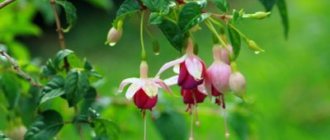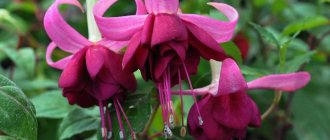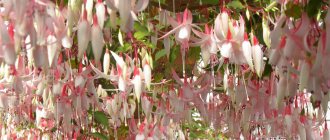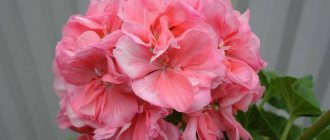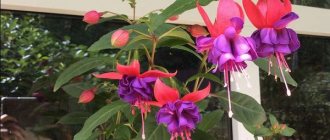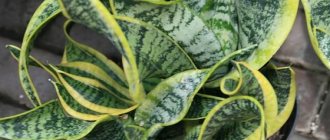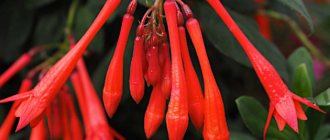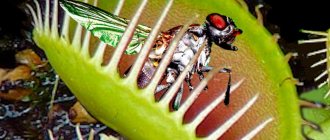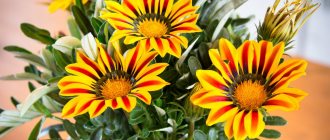Fuchsia is a perennial flowering shrub that has long been grown on windowsills. This plant is native to Central and South America. It is also found in New Zealand. Fuchsia is famous for its long and amazingly beautiful flowering.
Its flowers have an unusual shape, are very elegant and decorative. There are many varieties of this plant. In addition to indoor cultivation, it can also grow in open ground. It is successfully used for landscaping gardens and personal plots.
Features of fuchsia
Under natural conditions, fuchsia grows in mountain crevices and forests.
Fuchsia is a small tree or shrub with flexible reddish shoots and small green leaves. In nature, this plant is found in America and New Zealand. A special feature of fuchsia is its flowers, consisting of a calyx and a corolla.
This plant is absolutely safe for children and pets. Its fruits are edible and can be added to various desserts.
This is an unpretentious plant that even an inexperienced gardener can grow. This indoor flower will not only decorate any interior, but will also help create a favorable aura in the house. According to superstitions, fuchsia helps develop intuition and gives inspiration to creative people.
The shades of purple in the palette are named after this plant.
The color of fuchsia is considered to be a purple hue. But in fact, it is a collective definition of several shades of purple: from pale crimson to deep violet.
Photo: interior use
Fuchsia will fit perfectly into the living room interior
You can also grow fuchsia as a hanging plant by hanging a flower pot on the terrace or balcony
Fuchsia will decorate the window sill in the kitchen
Beautiful legend about fuchsia
There is a legend about the plant. It tells the story of seven charming sisters who knew how to dance beautifully. Everyone around them admired their dances, and even nature froze at that moment.
A sorcerer from a neighboring state, enchanted by the beauty and grace of the girls, decided to take one as his wife and make the rest as concubines.
The sisters opposed this decision. An angry magician turned them all into an extraordinary plant, the flowers of which resemble graceful dancers in lush tutus.
Since then, beautiful fuchsia with many lantern flowers has been pleasing with long flowering from May to mid-autumn.
Popular types and varieties with photos
There are about 100 species of this plant in nature. Most of them are suitable for growing at home. Breeders have also developed many different varieties, the flowers of which differ in shape and shade.
Graceful
In nature, graceful fuchsia can reach 3 meters in height, but in indoor conditions it is rarely higher than 1 m
This tall variety has beautiful large flowers. Fuchsia graceful blooms from spring to autumn.
Shining
Fuchsia radiant is a small shrub with purple flowers.
Fuchsia radiant, or shiny, is distinguished by purple-green leaves with pointed edges and crimson flowers with a crimson tint. With proper care, the plant will delight with lush and continuous flowering until the onset of cold weather.
Magellan
As a rule, Magellanic fuchsia flowers are collected in inflorescences
Fuchsia Magellanica is an evergreen shrub with large flowers, which can be single or collected in inflorescences of 4 pieces.
Blue Angel
Fuchsia Blue Angel looks especially impressive in wicker plant pots or elegant hanging baskets
One of the most popular forms of fuchsia is ampelous. The Blue Angel variety with double lilac flowers on snow-white sepals looks attractive in hanging flowerpots.
Description of the most popular indoor varieties of Fuchsia
Almost every type of fuchsia has been used to breed many varieties; a description of the most popular of them with photos and names is presented below. Sometimes you can recognize the mother specimen in them, especially when it comes to color.
Veenlust
Among the popular flowers used as indoor or outdoor plants, the ampel form is in great demand. The Veenlust variety of Dutch selection also belongs to the hanging type. It has flexible and long stems, which are recommended to be pinched at the beginning of growth so that the plant bushes more strongly.
Fuchsia Veenlust
The sepals are greenish in the tube area, turning white on the long petals. The corolla is red with white strokes, long stamens. Propagation from cuttings is quite difficult.
Adalbert Bogner
Another result of selection is bush fuchsia, which tolerates shearing well and takes root easily. Loves the sun, withstands direct rays. The leaves are thin, without edges, lanceolate.
Adalbert Bogner
The buds are large, pink and round, and the blooming flower shows a terry corolla-skirt of purple color with pink streaks, as if the petals were dipped in ink. The stamens are also deep purple at the ends. It blooms long and profusely, does not get sick.
Lenny Erwin
An ampelous version of indoor fuchsia with bright green ovoid leaves and flexible shoots.
Fuchsia Lenny Erwin
The buds are oblong, appearing side by side in several pieces. Double flowers. The top of the flower is medium-sized with white with green streaks, the corolla is soft lilac in the shape of a neat skirt with a thin edging along the edge, which creates the effect of waves and multi-levels. The look is very impressive and contrasting, attracting attention.
Natasha Sinton
Semi-ampelous, profusely flowering fuchsia. The leaves are green with red veins. The oblong buds open into delicate flowers with wavy petals in several rows.
Fuchsia Natasha Sinton
Branches well without special procedures. It blooms very generously, in armfuls. The flowers are large, combining all sorts of pink shades - from white-pink to ash-pink. Terry skirt of neat shape.
Pink Marshmallow
This “delicious” option was obtained by crossing white and pink fuchsias. The name of the variety is inspired by a large flower, which, with its double size and delicate shades of petals, really resembles the famous dessert. The buds are white with delicate strokes of green at the tip. The stamens are bright and contrasting. Blooms in spring.
Fuchsia Pink Marshmallow
The Pink Marshmallow variety is ampelous and medium-sized, does not exceed 40 cm, bushes well even without pinching. The stems are reddish and thin, the leaves are lanceolate and light green. Excellent cuttings, not afraid of cold weather. Doesn't like excess water in the pot. Suitable for novice gardeners.
Swingtime
An exclusive fuchsia variety with large double flowers. The sepals are of an intense red hue, the white corolla is diluted with red streaks and veins, it looks quite impressive and exotic. The buds look like small pomegranate fruits due to their shape and color.
Swingtime
Blooms in summer and autumn and grows quickly. It has a bush or ampelous shape.
Wattenpost
This fuchsia has strong shoots and can be formed into a bush or ampel if desired. It has small hard leaves.
Wattenpost
It blooms in clusters, the shape of the open bud is thin and elongated. The sepals are white or white-pink, the skirt is coral-red. The combination of bright red with white, diluted with delicate greenery, looks fresh and bright. The variety is not capricious, loves the scattered rays of the sun.
Voodoo
This fuchsia variety is perfect for beginning flower growers because it is easy to care for. In addition, it is valued for its contrasting color. The plant is rich in huge double flowers, the sepals are red, the skirt is intense purple with red tints.
Voodoo
Flowering early. Heart shaped buds. The leaves are elongated, medium-sized, with red veins. The bush is vigorous, reaches a height of 80 cm. The shoots quickly become woody, so sometimes Voodoo is formed into a trunk. Likes to live on the sunny side. Propagates well by cuttings.
Peppermint Stick
Another variety where the flower is “dipped in ink”: this effect is achieved by the corolla, whose petals are pink and have purple streaks at the ends. The sepals are pink, the tube is short, and the bud itself is large. Flowering occurs in early spring. Leaves are medium sized, elongated.
Fuchsia Peppermint Stick
It grows as a medium bush, up to half a meter. Branches well. It can be formed into a trunk, as the stems quickly become woody. Sun lover. It takes root well and overwinters painlessly at low temperatures.
It will also be interesting: Agapanthus (African rose) - planting and caring for the plant indoors and outdoors?
Planting: choosing a pot and soil
Nutritious, slightly acidic soil is suitable for growing fuchsia. The soil mixture can be prepared at home by mixing the following components:
- 3 parts leaf soil;
- 2 parts peat;
- 1 part sand.
Compo Sana brand universal soil is suitable for growing fuchsia.
The purchased flower can be grown in ready-made universal soil, which is sold in flower shops. When purchasing a soil mixture, you should pay attention to Rich Land and Compo Sana brand substrates.
A small clay pot with a hole for drainage is suitable for planting fuchsia.
The pot for planting fuchsia should be no more than 9 cm in diameter. It is advisable to plant the plant in a container made of ceramic or clay, since the growth and development of this indoor flower is adversely affected by overheating of the soil. A layer of expanded clay or small pebbles should be placed on the bottom of the selected pot, and then filled with soil mixture.
Description
The plant is a representative of the fireweed family. South and Central America is considered the homeland of the evergreen shrub. An amazing feature is that the plant has reddish stems. The leaves are small and oval in shape. Thanks to breeders, a large number of fuchsia flowers were bred. There are terry, two- and one-color varieties. The buds are located on long stalks. Thanks to their unusual shape, they resemble bright Chinese lanterns.
The crop is grown in the form of bushes. However, fuchsia is also suitable for creating standard trees (plants with a special crown shape), as well as compositions with other flowers. Since not all fuchsia varieties bloom at the same time, you can create a unique composition that will delight the eye from the beginning of spring until autumn. One of the interesting features of fuchsia is that any of its indoor varieties can be planted in flower beds, and vice versa.
Table: conditions of detention depending on the season
| Season | Lighting | Optimal temperature conditions | Humidity | Accommodation |
| Spring, summer and autumn | The plant is a light-loving plant, but it must be protected from exposure to direct sunlight. | It is desirable that the temperature be within +18…22°C | The optimal humidity level is 50%. It is recommended to place wide containers of water near the flower or place the pot with the plant on a tray with wet pebbles. On hot days, the pet should be additionally sprayed with settled water in the mornings and evenings. | It is recommended to place the pot on an east or west windowsill. In summer it is better to take it out onto the balcony |
| Winter | It is advisable to provide fuchsia with 12-hour additional lighting using a fluorescent lamp | The room temperature should not rise above +18 °C | Spraying is not required in winter. Humidity should be maintained at the same level | It is advisable to move the pot to the basement. If the plant is left on the window sill in the room for the winter, then it needs to be moved away from heating appliances. |
Wintering fuchsia on the loggia. Care for fuchsia in winter
After the shrub has entered a dormant state, it is necessary to carry out a number of measures to ensure normal winter hibernation and successful awakening in the spring.
The gardener must do the following:
- Carefully remove the bush from the flowerpot and conduct an external inspection for the presence of diseases and parasites. You need to remove the plant very carefully, as its roots can grow to the inner walls of the pot. It is better to throw old soil into the garden, as it can be contaminated with insect larvae and pathogens.
Clean fuchsia from parasitic insects and their eggs. Cut off diseased roots with pruning shears. They are easy to find by color - diseased fragments are black with a grayish tint. It is necessary to cut, capturing 5-10 mm of healthy wood to prevent re-infection.
Wash the inside of the flowerpot well and disinfect its walls. Arrange new drainage inside the pot and fill it with fresh fertile soil. Carefully place the bush into it.
After carrying out sanitary procedures, you need to place the fuchsia in a dark, damp place. In order to prevent the earthen clod from drying out and the roots from breaking, the plant must be periodically watered with clean, settled water.
Preparing fuchsia for wintering
If fuchsia is left warm for the winter, then there is a high probability that it will not bloom throughout the next season. This is one of the features of this beautiful but capricious flower.
Home care
When growing and caring for fuchsia at home, it is necessary to regularly perform the following procedures:
- watering;
- fertilization;
- pruning and pinching;
- transfer.
Watering
In summer, it requires frequent and abundant watering. At this time of year, it is advisable to water the plant every 4 days. Excess liquid must be drained from the pan immediately. With the onset of autumn, the frequency of watering should be reduced to once a week. In winter, fuchsia should be watered no more than 2 times a month.
Fertilizer application
It is recommended to feed fuchsia with fertilizer for ornamental flowering plants
You need to fertilize once every 2 weeks. It is necessary to feed fuchsia with complex fertilizers for ornamental flowering plants. Liquid fertilizers should be applied after watering. During the dormant period that occurs in fuchsia in winter, the plant does not need to be fed.
After planting and for a month after transplanting, there is no need to apply fertilizer to a new pot.
Transfer
Fuchsia must be replanted every year into a pot that is 3 cm larger in size than the old one. The procedure is recommended to be carried out in the spring. Transplantation is carried out using the transshipment method. Step-by-step instructions for the procedure:
- Fill the new pot with a layer of drainage and soil mixture.
- Remove the fuchsia from the old container along with the earthen lump.
- Move the plant to a new container.
- Fill the voids on the sides with soil.
- Trim the plant stems by a third.
- Place the fuchsia in a place with diffused lighting.
- Spray the foliage and water the plant generously.
Trimming and pinching
Pruning is required 2 times a year. In autumn, you need to remove faded flowers and shorten the branches by 2 cm from the dormant buds. The second pruning should be done in winter, removing dry leaves and branches. You should also cut off all long shoots with disinfected garden shears.
By pinching, you can give the plant the desired shape. In addition, this procedure promotes abundant flowering. Hanging plants should be pinched through 2 internodes, and bush plants - through 3 internodes.
Features of care at home and outdoors
The general rules are mostly the same, although there are differences. Despite the fact that fuchsia comes from the tropics or subtropics, growing the flower in southern gardens is a big problem due to the heat, whiteflies, and overheating of the root system.
Selecting a location
Ampelous fuchsia loves fresh air, but indoors, thanks to air conditioning, it is easier to control the temperature. The plant prefers very moderate temperatures, no more than 20-24° C.
Lighting needs to be intense, bright, but without direct midday rays:
- on the southern window sill protection in the form of a light curtain is required;
- in open ground - planting next to a fence, buildings or larger plants that cover the hanging fuchsia in the middle of the day.
The culture tolerates light partial shade; some cultivars can bloom in poor light, but not in deep shade. In flowerpots, bushes can be placed under a canopy or attached to the branches of a tree with an openwork crown.
Ampelous fuchsias are not planted in flat flower beds - when they come into contact with the ground, the long shoots begin to rot. But they can be placed on tall or terraced flower beds, or in stationary flowerpots.
Watering
Regular irrigation is needed, some sources recommend that the soil be constantly moist, others advise drying it out by a few millimeters. In summer, fuchsia may require daily watering. In flower beds, the soil is mulched with peat or bark to retain moisture; in pots, with sphagnum.
In cool weather and before the dormant period, watering is reduced.
Air humidity needs to be high. In hot weather, the bushes are sprayed several times a day, trying not to get it on the flowers.
Feeding
In the spring, to resume the growing season, grow new shoots and leaves, ampelous fuchsia needs nitrogen; during flowering, phosphorus, potassium plus microelements. The plant especially suffers from magnesium deficiency.
Every 2 weeks in the middle of the season, use complex mineral fertilizers for flowers with the same content of macroelements, for example, 10:10:10 or 20:20:20. Long-acting fertilizers can be used in potted crops.
From the end of summer, nitrogen is eliminated. Feed with phosphorus and potassium preparations.
Formation
Ampelous fuchsia blooms on the tops of the current year's shoots, but only a branched bush will be beautiful. You will have to sacrifice early flowering.
The following algorithm is suitable for young or adult plants, barely rooted cuttings:
- Branches that have grown a little after winter are pinched over 2-3 pairs of leaves.
- The same is done with all the side shoots until the bush takes on a beautiful lush shape.
Depending on the variety and care, 6-12 weeks will pass from the time of the last pinching to the flowering of the ampelous fuchsia.
At the peak of decorativeness, faded corollas and yellowed leaves are removed, and elongated thin shoots are shortened. In case of accidental pollination, which happens extremely rarely, it is better to remove the fruits - nothing worthwhile will grow if you collect the seeds.
At the end of the season, after the leaves of the ampelous fuchsia begin to fly off, the bush needs to be pruned. In hanging varieties, the shoots are shortened by about a third.
Transfer
Transshipment is allowed without disturbing the earthen coma of a flowering plant, although it is better to do this annually in the spring. The operation cannot be performed:
- during the dormant period, when some of the roots die off, life processes are suspended;
- at high temperatures – the crop does not tolerate heat well.
If you are going to plant ampelous fuchsia in open ground, do it after the ground has warmed up to 15° C. The above-ground part of most species and varieties tolerates a short-term decrease to 0° C, holds well at 5° C, but the root does not work, the buds may fall off , even leaves.
Wintering
In potted crops, reduce watering. Bushes are dug out from open ground after the leaves begin to fall, but the thermometer should not cross the zero mark even at night.
The ampelous fuchsias are trimmed by 1/3. Pick off the remaining leaves. Put away for storage.
Wintering on a northern windowsill is only suitable for young plants grown this season from cuttings or seeds. They should remain with the leaves unless they fall off on their own.
The rest of the fuchsias are sent to a frost-free basement, on a glazed balcony. Temperature:
- should not exceed 12° C;
- it is better if it ranges from 6 to 10 ° C;
- permissible minimum – plus 2° C;
- A short-term decrease to 0° C will not cause significant harm.
Reproduction methods
Fuchsia can be propagated in the following ways:
- cuttings;
- leaves;
- seeds.
The easiest way to propagate fuchsia is by cuttings
Most often, flower growers resort to cuttings, which are carried out in the spring. Step-by-step instructions for propagating fuchsia by cuttings:
- Cut several 15-centimeter cuttings from the mother plant (it is advisable to do this in early autumn).
- Remove the lower leaves from the shoots.
- Pack the cuttings in a bag of sawdust and place them on the bottom shelf of the refrigerator.
- With the onset of spring, remove the shoots from the refrigerator and treat them with a manganese solution.
- Place the cuttings in jars with filtered water.
- Cover them with polyethylene on top.
- Transplant the cuttings after 2 weeks into prepared pots with drainage and soil mixture.
If it is not possible to cut cuttings suitable for propagation from fuchsia, then the plant can be propagated by leaves. In this case, the procedure should be carried out as follows:
- Cut off a large leaf along with the cuttings.
- Bury the sheet 1 cm into moistened perlite.
- Cover the container with polyethylene.
- Carry out daily spraying.
- Separate the resulting rosette of leaves from the leaf as soon as it is strong enough.
- Plant the rosette in a separate container with soil mixture.
Propagation by seeds is carried out extremely rarely, since this method is complex and time-consuming.
Video: cuttings
Dark fuchsia and its combination
The combination of dark fuchsia is harmonious, where each tone is part of the whole. To build an advantageous range, you will need complex and rich colors, such as sunset pink, hot pink, coral burgundy, orange, pumpkin, banana, amber, olive green, pine color, Prussian blue, sapphiol, crane violet, eggplant , chocolate, light beige, black-gray.
dark rich pink can be used as an everyday tone or as an evening tone.
Problems during cultivation
If the gardener does not care properly when growing this ornamental plant, the following problems may arise:
- Falling buds. In this case, you need to lower the temperature in the room, adjust the frequency of watering, feed the plant and provide it with sufficient lighting.
- Yellowing of foliage. This situation occurs when overwatering.
- Falling leaves. Dry indoor air, elevated temperatures and lack of fertilizers lead to this problem.
- Lack of flowering. In order for the plant to bloom at the right time, it must be pruned in a timely manner and provided with sufficient lighting. It is also recommended not to overfeed fuchsia with nitrogen fertilizers, as they negatively affect flowering.
- The appearance of dark spots on the leaves. In this case, it is recommended to reduce the humidity and ventilate the room.
Purple fuchsia and its combination
The combination of purple fuchsia always has a slightly evening character. The velvety tone of purple surrounds itself with mysteries and promises. Pair him with slightly darkened but rich shades, such as white-lilac, lilac, coral-red, tangerine, red-orange, corn, yellow-orange, Kelly color, emerald, Prussian blue, thunderstorm, charoite, eggplant, dark chocolate, lead, blue black.
Diseases and pests
Fuchsia can suffer from the following diseases and pests:
- Whitefly. Most often, fuchsia is attacked by these parasites and it is quite difficult for this ornamental plant to resist them. Folk remedies will not help get rid of them and you will need to use Angara for treatment. Before treating with this preparation, it is recommended to wash the plant with running water and laundry soap, covering the root system with a film so that the soap solution does not get on them.
- Spider mite. Fufanon will help get rid of parasites.
- Rust. In sick fuchsia, the affected leaves should be removed. Then you need to treat the plant with a soap solution.
- Root rot. The diseased plant must be removed from the pot, the roots washed and the rotten roots cut off. Then the fuchsia must be placed in a container with filtered water. When the plant has formed healthy roots, it can be transplanted into a new container with fresh soil.
Photo: symptoms of infection
Spider mites can be identified by the webs that appear on the undersides of leaves.
Whitefly larvae can be seen on the leaves of the plant
A sign of rust are brownish spots on the leaves of the plant.
With root rot, the roots of the plant begin to turn black.
Bright fuchsia: how to combine?
Bright fuchsia is combined with equally piercing colors. If we take the “pluck out your eye” image, then the path retains its original harmony. To do this, you will need the following colors: sakura color, coral pink, scarlet red, yellow-orange, orange, canary, signal yellow, toad in love, kelly, turquoise, blue-blue, lilac, purple, bark color, light beige, wet asphalt.
This tone is dangerous: not only does it disproportionately excite the psyche, it can highlight all the existing flaws in the figure: the color makes you look fat, creating the illusion of a grayer complexion. Therefore, be sure to follow the recommendations regarding the color type of appearance (see below)
Signs and superstitions
Every plant has some kind of superstition associated with it. Is it good or bad for this plant to be at home? As for fuchsia, many positive qualities are attributed to it.
When this plant is in a house or apartment, it:
- helps develop intuition and creative skills;
- harmonizes the energy in the room;
- supports health in those who suffer from diseases of the thyroid gland and digestive system;
- promotes mutual understanding between children and parents;
- drives away apathy and helps find a way out in a difficult situation;
- adds cheerfulness;
- makes its owner irresistible and charming.
There is also a superstition that fuchsia is a widow's flower . But, despite this, the flower is so luxurious and charming that almost none of the female flower growers attach importance to this strange statement.
White and beige
It's hard to go wrong with these shades. White and beige will successfully highlight any shade of fuchsia and make it even more saturated. So let neutral colors dominate your look.
Total-look
One of the most spectacular images is the fuchsia total-look. Combine similar shades of this palette in your outfits or choose one of them as dominant.
Who should wear fuchsia color in clothes?
This rich pink isn't for everyone. First of all, it can be used by representatives of the “winter” color type. For “summer” this color is too bright; more muted or darker shades of fuchsia pink are suitable for them. Oddly enough, deep pink looks good in the “spring” due to bright makeup, which contrasts the appearance.
Remember: very bright colors can seriously spoil your biological appearance. Follow the recommendations for color types to always look your best:
“Spring” should choose the following fuchsia tones: pink, bright, red. For “winter” there will be a similar set: pink, bright, purple. “Summer” should be content with medium fuchsia, dark and purple. “Autumn” will be able to be content with red, dark and purple shades.
Outerwear
Those who like to stand out from the crowd can make a statement with outerwear in the fashionable fuchsia color - a coat, raincoat, trench coat, fur coat or down jacket. Combinations with animal or checkered prints are welcome.
Accessories
If you want to spice up a gray business outfit or an elegant dress and make it stand out, pair it with a fuchsia handbag. You can also add a pop of color to your jewelry, belts, watches, silk scarves, or lipstick.
Curious pedigree of the plant
Natural types of fuchsia are witnesses to the history of the powerful Indian people, the successor of the traditions of the Inca Empire in South America. This beautiful flower was brought to Europe from Chile in the 18th century. Straight to the English royal court.
The genus of plants Fuchsia belongs to the fireweed family (Onagraceae) and has 107 species growing in natural conditions. Breeders have created hybrid fuchsia, many of its varieties, representing an incredible palette of petals.
Interesting facts:
- The Frenchman C. Plumier, who discovered the species in 1696 on a scientific expedition to the Greater Antilles, gave it the name in honor of L. Fuchs, a German botanist.
- In 1853, the first fully double fuchsia variety was developed.
- The father of genetics, Gregor Mendel, called this flower his favorite plant and chose it for his coat of arms.
Wild fuchsias are annual or perennial plants that live on the edges of tropical forests at altitudes of up to 3000 m in the light shade of tall trees. Flowers in the room also require high humidity and shading from the scorching sun. Getting acquainted with tips on how to grow fuchsia should begin with studying the varieties and growing conditions.
